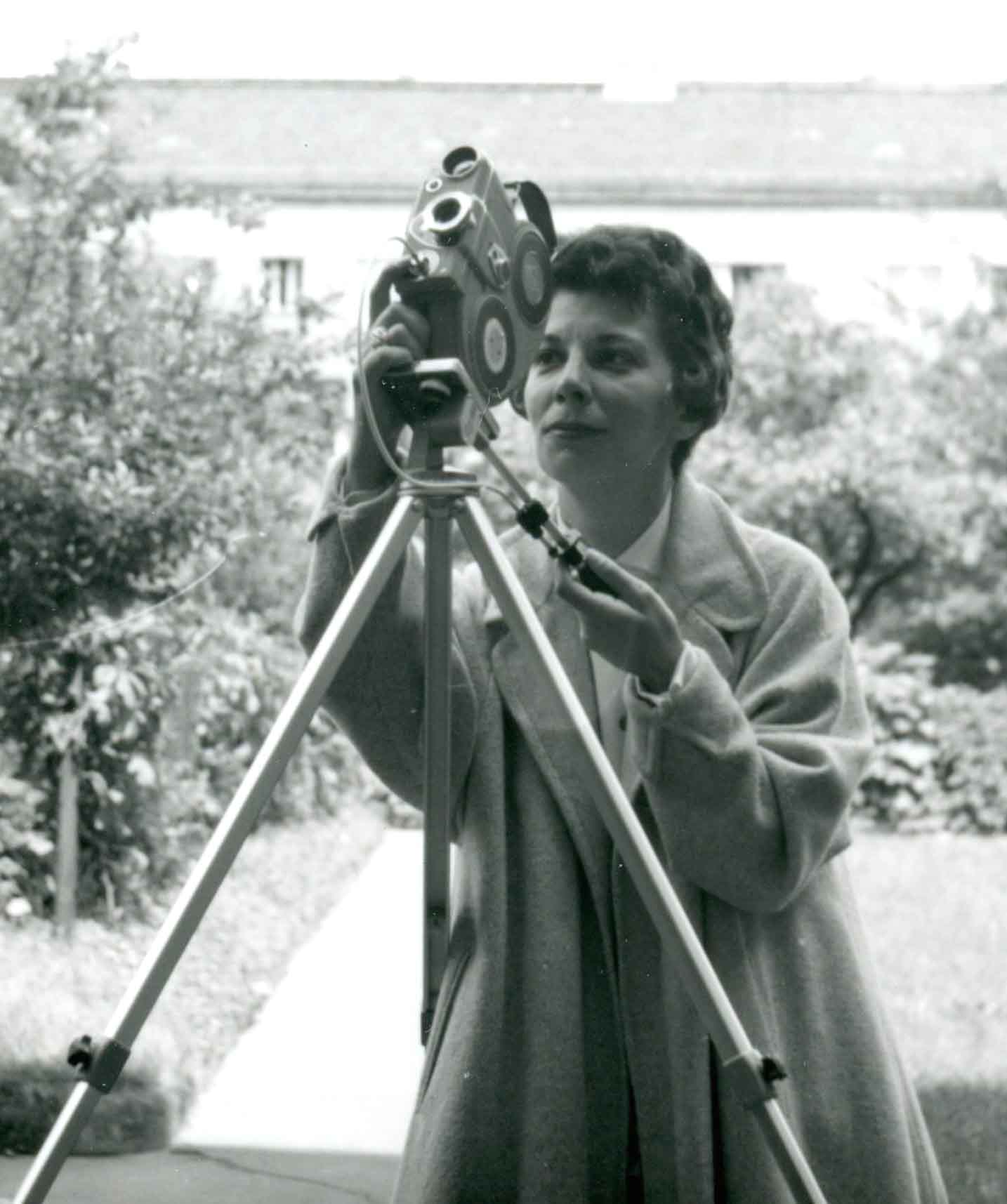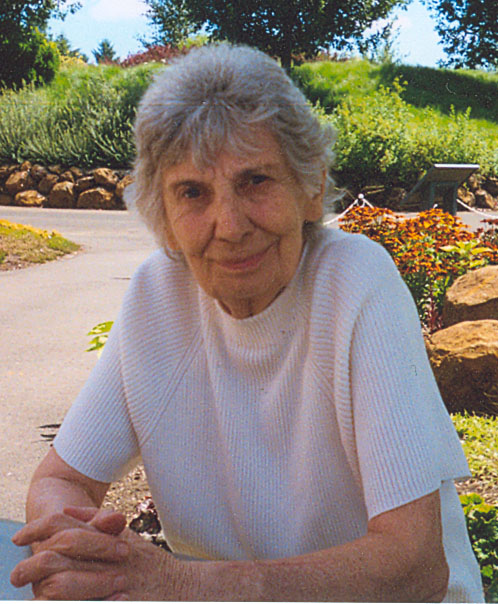


Prague, 1943
Circa 1960
2009
Johanna Alemann passed away on November 25, 2012. View Stewart
Nestor's 2021 documentary film
Mr.Alemann, winner of
multiple film festival awards. Also view Nestor's photo essay tribute to her,
A Life Well-Lived,
and her films below. Johanna donated her films to the AFA upon her passing. We have used that donation
to
make her films available for free public viewing on the AFA collection site at
the Internet Archive. To watch a film, click on the film links below, in the
filmography.
Johanna Alemann is believed to be the first woman filmmaker, operating as
a sole proprietor, to run an academic film company in North America. Born near Berlin in Woltersdorf, Germany on July
11, 1923, Alemann had U.S. citizenship from birth due to the fact that her
father was from the United States. She had no training in filmmaking when she
bought a 16mm camera for a trip to Berlin, but returned with footage, which she
made into her first film, Berlin, Outpost of Freedom (1959). She showed
her film to Bertha Landers of Landers Film Reviews and received a glowing
review, which resulted in her film being acquired by school film libraries. She
soon became friends with Southern California academic filmmakers
J. Michael Hagopian and Thomas Stanton, and
enjoyed recounting
their conversations around how many contemporary educational films were nothing more than
"nuts and bolts" material, and that they wanted to make a more interesting,
insightful film for students and teachers. She began her company Alemann Films
in Los Angeles, and produced roughly one film per year. For a period of ten
years, she supported her filmmaking efforts by working a 40 hour shift as an
X-ray technician during weekends.
Alemann's filmmaking philosophy was to approach an idea "clearly, logically,
and with good understanding " of the subject matter. She remembers taking her
idea of making a film on Rococo art to one school district, who told her that
the film would have limited appeal. After making the film, the same district
ultimately bought 10 copies of it, and it became a successful film for her,
from a financial perspective. Her
best selling films were in Alemann's History Through Art series, and
Art Portrays a Changing World: Gothic to Early Renaissance (1963) is her
personal favorite. In 1980, she wrote a book espousing her philosophy on the art
of making choices, The Pendulum of Choice (1980). She spent her last
years in the town of Mt. Angel, Oregon.
In terms of technique, Alemann might be described as a painterly
cinematographer influenced by Impressionism, especially evidenced in her 'Inspirations from
Nature' series. Her framing was magnificent, notably in her 'Changing
Environment USA' series. She was an exceptional writer. An additional element of
her work was truly unique: all of her distribution prints were made on
Ektachrome film stock, an
expensive process and one which was resistant to color fading. As a result, all
of her extant prints have retained their color. Nearly all of the companies
making classroom academic films in her era used Eastmancolor stock for
distribution prints, which ultimately red-shifted. To our
knowledge, her firm was the only one in the educational film industry to utilize Ektachrome for every distribution print.
Filmography
Berlin: Outpost of Freedom (1959) Portrays how Berlin is a
focal point of world tension which has accumulated since the end of World War
II, and how it is the pinnacle of stress between the allied and communist
countries today. For the film, Alemann shot contraband footage of East Berlin
from a camera hidden under her coat and narrowly escaped detection. She also released a German language version of this
film, Berlin: Insel Der Freiheit.
History Through Art series:
Age of the Rococo, The: From Devine Right to Equality (1964)
Shows the relationship of the elaborate and ornate art of the Rococo Period to
social thinking of the time. Discusses transition from the Louis XIV baroque era
to the rococo. Interiors and exteriors of buildings (German and Austrian
churches) , furniture, porcelain, and painting (Watteau). Describes how the
gaiety of the era would soon be eclipsed by the age of revolutions.
Art Portrays a Changing World: Gothic to Early Renaissance (1963)
Describes the historical transformation of medieval man to modern man. Points
out that Gothic art expressed the community spirit of the Middle Ages. Contrasts
Gothic to Renaissance art which reflects man's awakening interest in science,
nature and himself. Discusses architecture, sculptures, stained glass windows,
and painted altarpieces in the cathedrals, and describes the evolution of
painting.
Democracy of Ancient Greece: The Age of Excellence (1966)
Discusses the social, political and cultural aspects of Greece's golden age and
analyzes the philosophy on which the society was based. Stunning cinematography
by Gunther Von Fritsch, including Acropolis, Agora, Delfi, Corinth. Shows
American artist Ralph Hulett at work at Greek historical sites.
Europe in Transition: The Late Middle Ages (1963) Describes the
foundations of European culture and society in the Middle Ages, from 1200 to
1500 ACE. Discusses the church, nobility, and the emperors, three pillars of
early medieval society. Describes changes that reshaped Europe and resulted in
the present Western civilization, including the advent of small towns along
trade routes, the Magna Carta, the development of the middle class, and the
formation of hospitals and universities. Explains the intellectual awakening
during the transition to the Renaissance. Discusses the Crusades, the Black
Plague, and moveable type.
Recognition of Man: The Renaissance (1968) Shows that the main
Renaissance contribution to Western culture was the recognition of the
individual in life and art. Explains that one of the most significant creations
of the Renaissance was portraiture, a new category of art which reveals man's
developing awareness of his active destiny in life. Surveys portraiture from the
13th through 16th centuries, including Flemish, Italian, and German painters such
as Titian, Michelangelo, Leonardo, and Durer.
Twentieth Century Art: A Break with Tradition (1965) Discusses how
modern artists defied tradition in their search for new dimensions of
expression. Shows how artists use novel styles and techniques to interpret the
ever-changing face of twentieth century life. Discusses Fauvism, German
Expressionism, Cubism, Surrealism, Abstract Expressionism, Italian Futurism.
Changing Environment USA series:
From the Desert to the Sea (1971) Contrasts man's thoughtless abuse
of his environment with the unspoiled beauties of nature. Alemann's painterly
camera captures impressionistic views of Yosemite's waterfalls, forest wildlife,
mountain trees and flowers, and Monterey cypresses.
Modern Identity, A (1971) Describes how American architecture is
defining a new identity. Focusing on New York and Los Angeles architecture,
discusses New York's Lever and Seagram's (Mies Van Der Rohe) buildings, glass walls and steel
construction, concrete curved forms, and juxtaposes similarities in ancient and
modern architecture. Wonderful night and day cinematography.
Our Changing Skylines: Mirror of the World (1970) Shows the
transition in America from traditional designs in architecture and art to a
unique, modern style.
Place of Belonging (1972) Creates an awareness of the different
forms of beauty found in cities. Explains that art, not luxury, is necessary and
that nature enriches cities. Shots of San Francisco, Rome, and the Gold Rush
town of Columbia, California.
Extols the modern outdoor shopping mall, enhanced by public art and parks, as an
important aspect of civic architecture and design.
Vanishing Heritage, A (1971) Reveals the many-sided heritage of American
architecture. Explains that traditions in architecture were brought to the
United States by people of many different nationalities, and that they were
blended with historical styles reaching back in time to Ancient Greece and Rome
to produce a culture uniquely American. Focuses on San Francisco, including the
palace of Fine Arts and the Palace of the Legion of Honor.
Inspirations from Nature series:
Color in Art: Rules of Harmony (1965) Discusses the color wheel as
a guideline for color relationships, focusing on mixing colors, analogous and
monochromatic hues, and color value and intensity.
Color in Nature (1965) Filmmaker Guy D. Haselton had made an
earlier film of this title, edited by Johanna Alemann. She then
made a new version edited from unused Haselton footage.
Little Tree That Had a Dream, The (1969) A pastiche of spectacular
nature shots accompanied by an orchestral score, with the minimal theme of a Joshua tree that dreamed of the far-away places he wanted to see.
Nature as Impression (1969) Illustrates the impressionistic concept of
viewing and painting nature. An analysis of Impressionist paintings
as they relate to color and shading in nature, focusing on Impressionists Manet,
Monet, and Renoir, and Post-Impressionists Cezanne, Seurat, and Van Gogh.
Nature as Reality (1969) Illustrates the realistic concept of viewing
and painting nature. Discusses how Durer, Breughel, Rubens, Constable, and Corot
painted landscapes. Describes line, geometric shapes, and perspective.
Miscellaneous other films
Age of Steam, The: Power for Progress (1965?) Describes man's
lack of technical progress until the Industrial Revolution, when the discovery
of steam as a source of power brought rapid advances. Depicts the nineteenth
century and the vast changes in living conditions caused by the utilization of
steam.
Animal Alphabet (1972) Relates the letters of the alphabet to different
animals in order to help children memorize the alphabet.
What Happened to My Backyard Shouldn't Happen to a Dog (1971)
Alemann filmed the construction of a swimming pool at her home in Los Angeles at
1021 San Pascual Avenue, showing her backyard being drastically changed. The
construction of a swimming pool is documented, from the reconstruction of her
back yard to the sequential construction process. Out of the footage, she
created a marvelous film about swimming pools, featuring neighborhood children
and her dog Pucci.